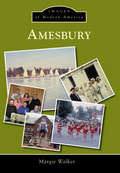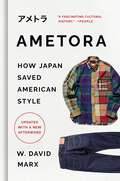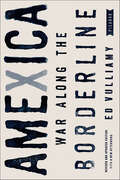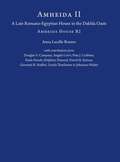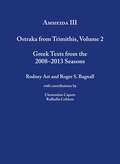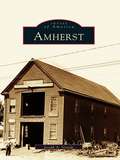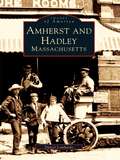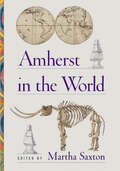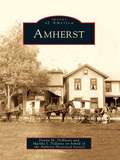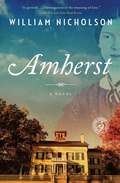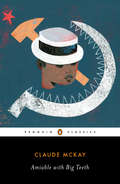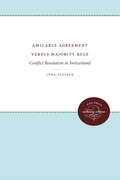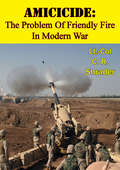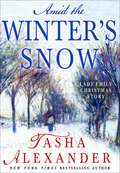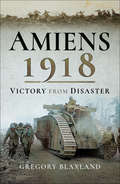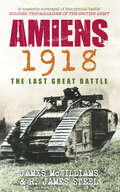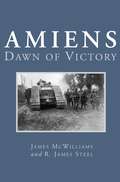- Table View
- List View
Ames: A Ride Through Town on the "Dinkey" (Images of America)
by Farwell T. BrownAmes has been referred to as a railroad town; more correctly the railroad established itself at the same moment that Iowa Agricultural College, now Iowa State University, was taking form. While the railroad helped to develop Ames, it was the college that drew people with names like Welch, Beardshear, "Tama Jim" Wilson, Charles F. Curtiss, and their successors. The flourishing academic community also drew families like the Loughrans and the Tildens, who were attracted by the positive town-gown relationship.In Ames: A Ride Through Town on the "Dinkey," readers will meet some of these people and tour historic Ames, as the narrow-gauge train nicknamed the "Dinkey" weaves its way through the city's history in over 220 vintage photographs. The images in this book, featuring people and landmarks both past and present, include Ames native J. Herman Banning, the first African-American aviator to be licensed in the U.S.; the dramatic 1922 burning and destruction of the Iowa State College Armory; a rare image of the 1895 Iowa State football team, the first to be called the Cyclones; and finally, downtown Ames' growth from dirt streets with wooden sidewalks to a modern college town.
Amesbury (Images of Modern America)
by Margie WalkerIn 1968, Amesbury celebrated its 300th anniversary. Residents compiled a cookbook, commemorative coins were sold, dances and plays were held, and townspeople dressed in period costume as part of the many events for the town's tercentenary. Since then, Amesbury has grown considerably, with many new businesses--furniture makers, fine food products, Norman's Restaurant, and clothing shops--emerging. Old mills have been reinvented into spaces for artists, photographers, and other creative outlets. The downtown area has been redeveloped and is a welcoming site as one enters Amesbury. One only needs to sit in Market Square, stroll along the Riverwalk, watch the falls of the Powow River in the Millyard, or listen to a concert in the amphitheater to experience Amesbury's charm. Despite a 1996 vote changing the town into a city, this great community retains the same small-town feel it has held for so many years.
Ametora: How Japan Saved American Style
by W. David MarxLook closely at any typically "American" article of clothing these days, and you may be surprised to see a Japanese label inside. From high-end denim to oxford button-downs, Japanese designers have taken the classic American look--known as ametora, or "American traditional"--and turned it into a huge business for companies like Uniqlo, Kamakura Shirts, Evisu, and Kapital. This phenomenon is part of a long dialogue between Japanese and American fashion; in fact, many of the basic items and traditions of the modern American wardrobe are alive and well today thanks to the stewardship of Japanese consumers and fashion cognoscenti, who ritualized and preserved these American styles during periods when they were out of vogue in their native land. In Ametora, cultural historian W. David Marx traces the Japanese assimilation of American fashion over the past hundred and fifty years, showing how Japanese trendsetters and entrepreneurs mimicked, adapted, imported, and ultimately perfected American style, dramatically reshaping not only Japan's culture but also our own in the process.
Amexica: War Along the Borderline
by Ed VulliamyAmexica is the harrowing story of the extraordinary terror unfolding along the U.S.-Mexico border—"a country in its own right, which belongs to both the United States and Mexico, yet neither"—as the narco-war escalates to a fever pitch there.In 2009, after reporting from the border for many years, Ed Vulliamy traveled the frontier from the Pacific coast to the Gulf of Mexico, from Tijuana to Matamoros, a journey through a kaleidoscopic landscape of corruption and all-out civil war, but also of beauty and joy and resilience. He describes in revelatory detail how the narco gangs work; the smuggling of people, weapons, and drugs back and forth across the border; middle-class flight from Mexico and an American celebrity culture that is feeding the violence; the interrelated economies of drugs and the maquiladora factories; the ruthless, systematic murder of young women in Ciudad Juarez. Heroes, villains, and victims—the brave and rogue police, priests, women, and journalists fighting the violence; the gangs and their freelance killers; the dead and the devastated—all come to life in this singular book.Amexica takes us far beyond today's headlines. It is a street-level portrait, by turns horrific and sublime, of a place and people in a time of war as much as of the war itself.
Amheida I: Ostraka from Trimithis, Volume 1 (ISAW Monographs #7)
by Roger S. Bagnall Giovanni R. RuffiniThis volume presents 455 inscribed pottery fragments, or ostraka,found during NYU’s excavations at Amheida in the western desert of Egypt. Themajority date to the Late Roman period (3rd to 4th century AD), a time of rapidsocial change in Egypt and the ancient Mediterranean generally. Amheida was asmall administrative center, and the full publication of these brief textsilluminates the role of writing in the daily lives of its inhabitants. Thesubjects covered by the Amheida ostraka include the distribution of food, theadministration of wells, the commercial lives of inhabitants, their education,and other aspects of life neglected in literary sources. The authors provide afull introduction to the technical aspects of terminology and chronology, whilealso situating this important evidence in its historical, social and regionalcontext. Online edition available as part of the NYU Library's Ancient World Digital Library and in partnership with the Institute for the Study of the Ancient World (ISAW).
Amheida II: A Late Romano-Egyptian House in the Dakhla Oasis: Amheida House B2 (ISAW Monographs #4)
by Anna Lucille BoozerThis archaeological report provides a comprehensive study of the excavations carried out at Amheida House B2 in Egypt's Dakhleh Oasis between 2005 and 2007, followed by three study seasons between 2008 and 2010.The excavations at Amheida in Egypt's western desert, begun in 2001 under the aegis of Columbia University and sponsored by NYU since 2008, are investigating all aspects of social life and material culture at the administrative center of ancient Trimithis. The excavations so far have focused on three areas of this very large site: a centrally located upper-class fourth-century AD house with wall paintings, an adjoining school, and underlying remains of a Roman bath complex; a more modest house of the third century; and the temple hill, with remains of the Temple of Thoth built in the first century AD and of earlier structures. Architectural conservation has protected and partly restored two standing funerary monuments, a mud-brick pyramid and a tower tomb, both of the Roman period.This volume presents and discusses the architecture, artifacts and ecofacts recovered from B2 in a holistic manner, which has rarely before been attempted in a full report on the excavation of a Romano-Egyptian house. The primary aim of this volume is to combine an architectural and material-based study with an explicitly contextual and theoretical analysis. In so doing, it develops a methodology and presents a case study of how the rich material remains of Romano-Egyptian houses may be used to investigate the relationship between domestic remains and social identity.
Amheida III: Ostraka from Trimithis, Volume 2 (ISAW Monographs #5)
by Roger S. Bagnall Rodney AstThis archaeological report provides a comprehensive study of the excavations carried out at Amheida House B2 in Egypt's Dakhleh Oasis between 2005 and 2007, followed by three study seasons between 2008 and 2010. The excavations at Amheida in Egypt's western desert, begun in 2001 under the aegis of Columbia University and sponsored by NYU since 2008, are investigating all aspects of social life and material culture at the administrative center of ancient Trimithis. The excavations so far have focused on three areas of this very large site: a centrally located upper-class fourth-century AD house with wall paintings, an adjoining school, and underlying remains of a Roman bath complex; a more modest house of the third century; and the temple hill, with remains of the Temple of Thoth built in the first century AD and of earlier structures. Architectural conservation has protected and partly restored two standing funerary monuments, a mud-brick pyramid and a tower tomb, both of the Roman period. This is the second volume of ostraka from the excavations Amheida (ancient Trimithis) in Egypt. It adds 491 items to the growing corpus of primary texts from the site. In addition to the catalog, the introductory sections make important contributions to understanding the role of textual practice in the life of a pre-modern small town. Issues addressed include tenancy, the administration of water, governance, the identification of individuals in the archaeological record, the management of estates, personal handwriting, and the uses of personal names. Additionally, the chapter "Ceramic Fabrics and Shapes” by Clementina Caputo breaks new ground in the treatment of these inscribed shards as both written text and physical object. This volume will be of interest to specialists in Roman-period Egypt as well as to scholars of literacy and writing in the ancient world and elsewhere.
Amherst
by Joseph A. GrandeAmherst depicts the breathtaking evolution of a small farming community into a major economic, educational, and medical hub of western New York. The book reveals how Amherst's rich soils, rapid falls, and near-Buffalo location led to the community's great progress and growth. In a single century, the population rose from just over four thousand in 1900 to one hundred fifteen thousand in 2000. Today, the town includes the thousand-acre campus of the new State University of New York at Buffalo and the Amherst Museum, visited by more than fifty thousand people each year.
Amherst and Hadley, Massachusetts (Images of America)
by Daniel LombardoOnce part of Hadley, the town of Amherst is known the world over as the home of celebrated poet Emily Dickinson. This photographic portrait of Emily'ssurroundings reveals the beautiful landscape that inspired her art, and also includes less typical but nonetheless significant images of hard-working farmhands, Irish laborers, Italian peanut vendors, riotous college students, and feuding factory workers. These two towns at the heart of the Connecticut River Valley have been appreciated by poets and artists for many years, and their bucolic and pastoral character is celebrated in this marvelous new examination of the towns' historyin photographs from 1860 through the early twentiethcentury. Famous residents of and visitors to the area are featured, including Dickinson, Robert Frost, Henry Ward Beecher and Noah Webster. Mr. Lombardo's book combines a serious look at these historical figures with a humorous perspective on some of the area's more colorful characters, such as Charles King, the Amherst barber who became famous for eating fifty eggs in fifteen minutes.
Amherst and Hadley: Through the Seasons (Images of America)
by Daniel LombardoNestled deep in the Connecticut River Valley areAmherst and Hadley, two New England towns responsible for the inspiration of many classic poets, writers, and thinkers of America. In Amherst and Hadley: Through the Seasons, the landscape changes continuously throughout the seasons. Each season brings its own natural beauty and dangers, from the scorching summers to the bitter winters.This photographic history offers a rare glimpse of Robert Frost's world of fire and ice. Visit a place where Ralph Waldo Emerson ate dinners with Emily Dickinson's family and see the site on which Noah Webster founded Amherst College. Look through a visual record of small towns, where the seasonal changes of the hills, fields, and woods inspired local writer Ray Stannard Baker and area photographer Clifton Johnson. Meander through a place that left fond memories in the hearts and minds of former Supreme Court Chief Justice Harlan Fiske Stone and writer Sylvia Plath.
Amherst in the World
by Martha SaxtonIn celebration of the 200th anniversary of Amherst College, a group of scholars and alumni explore the school’s substantial past in this volume. Amherst in the World tells the story of how an institution that was founded to train Protestant ministers began educating new generations of industrialists, bankers, and political leaders with the decline in missionary ambitions after the Civil War. The contributors trace how what was a largely white school throughout the interwar years begins diversifying its student demographics after World War II and the War in Vietnam. The histories told here illuminate how Amherst has contended with slavery, wars, religion, coeducation, science, curriculum, town and gown relations, governance, and funding during its two centuries of existence. Through Amherst’s engagement with educational improvement in light of these historical undulations, it continually affirms both the vitality and the utility of a liberal arts education. Contributions by Martha Saxton, Gary J. Kornblith, David W. Wills, Frederick E. Hoxie, Trent Maxey, Nicholas L. Syrett, Wendy H. Bergoffen, Rick López, Matthew Alexander Randolph, Daniel Levinson Wilk, K. Ian Shin, David S. Reynolds, Jane F. Thrailkill, Julie Dobrow, Richard F. Teichgraeber III, Debby Applegate, Michael E. Jirik, Bruce Laurie, Molly Michelmore, and Christian G. Appy.
Amherst: 1881-1982 (Images of America)
by Amherst Historical Society Donna M. Deblasio Martha I. PallanteEstablished in 1811, Amherst has been actively engaged in the quarrying of high-quality sandstone since before the American Civil War. The products of the town's quarries have graced buildings and other structures in the United States and around the world. The promise of work at the quarries drew potential employees from the surrounding countryside, as well as from across the ocean, giving the community's population its diverse character. This photographic history presents the unique and fascinating story of Amherst, the self-described "Sandstone Center of the World."
Amherst: A Novel
by William NicholsonFrom an Oscar-nominated screenwriter and the author of Motherland, a novel about two love affairs set in Amherst--one in the present, one in the past, and both presided over by Emily Dickinson.Alice Dickinson, a young advertising executive in London, decides to take time off work to research her idea for a screenplay: the true story of the scandalous, adulterous love affair that took place between a young, Amherst college faculty wife, Mabel Loomis Todd, and the college's treasurer, Austin Dickinson, in the 1880s. Austin, twenty-four years Mabel's senior and married, was the brother of the reclusive poet Emily Dickinson, whose house provided the setting for Austin and Mabel's trysts. Alice travels to Amherst, staying in the house of Nick Crocker, a married English academic in his fifties. As Alice researches Austin and Mabel's story and Emily's role in their affair, she embarks on her own affair with Nick, an affair that, of course, they both know echoes the affair that she's writing about in her screenplay. Interspersed with Alice's complicated love story is the story of Austin and Mabel, historically accurate and meticulously recreated from their voluminous letters and diaries. Using the poems of Emily Dickinson throughout, Amherst is an exploration of the nature of passionate love, its delusions, and its glories. This novel is playful and scholarly, sexy and smart, and reminds us that the games we play when we fall in love have not changed that much over the years.
Amiable Scoundrel: Simon Cameron, Lincoln's Scandalous Secretary of War
by Paul KahanFrom abject poverty to undisputed political boss of Pennsylvania, Lincoln’s secretary of war, senator, chair of the Senate Foreign Relations Committee, and a founder of the Republican Party, Simon Cameron (1799–1889) was one of the nineteenth century’s most prominent political figures. In his wake, however, he left a series of questionable political and business dealings and, at the age of eighty, even a sex scandal. Far more than a biography of Cameron, Amiable Scoundrel is also a portrait of an era that allowed—indeed, encouraged—a man such as Cameron to seize political control. The political changes of the early nineteenth century enabled him not only to improve his status but also to exert real political authority. The changes caused by the Civil War, in turn, allowed Cameron to consolidate his political authority into a successful, well-oiled political machine. A key figure in designing and implementing the Union’s military strategy during the Civil War’s crucial first year, Cameron played an essential role in pushing Abraham Lincoln to permit the enlistment of African Americans into the U.S. Army, a stance that eventually led to his forced resignation. Yet his legacy has languished, nearly forgotten save for the fact that his name has become shorthand for corruption, even though no evidence has ever been presented to prove that Cameron was corrupt.Amiable Scoundrel puts Cameron’s actions into a larger historical context by demonstrating that many politicians of the time, including Abraham Lincoln, used similar tactics to win elections and advance their careers. This study is the fascinating story of Cameron’s life and an illuminating portrait of his times.
Amiable with Big Teeth
by Brent Hayes Edwards Claude Mckay Jean-Christophe CloutierA monumental literary event: the newly discovered final novel by seminal Harlem Renaissance writer Claude McKay, a rich and multilayered portrayal of life in 1930s Harlem and a historical protest for black freedom<p><p> The unexpected discovery in 2009 of a completed manuscript of Claude McKay’s final novel was celebrated as one of the most significant literary events in recent years. Building on the already extraordinary legacy of McKay’s life and work, this colorful, dramatic novel centers on the efforts by Harlem intelligentsia to organize support for the liberation of fascist-controlled Ethiopia, a crucial but largely forgotten event in American history. At once a penetrating satire of political machinations in Depression-era Harlem and a far-reaching story of global intrigue and romance, Amiable with Big Teeth plunges into the concerns, anxieties, hopes, and dreams of African-Americans at a moment of crisis for the soul of Harlem—and America.
Amicable Agreement Versus Majority Rule: Conflict Resolution in Switzerland
by Jürg SteinerWhen the German edition of Steiner's masterful analysis of Switzerland's political system was first published in 1970 as Gewaltlose Politik und kulturelle Vielfalt, it was greeted by the American Political Science Review as a laudable departure from conventional comparative series." This new edition, extensively revised and expanded, makes Steiner's innovative study available to political theorists in the English-speaking world."Originally published 1974.A UNC Press Enduring Edition -- UNC Press Enduring Editions use the latest in digital technology to make available again books from our distinguished backlist that were previously out of print. These editions are published unaltered from the original, and are presented in affordable paperback formats, bringing readers both historical and cultural value.
Amicicide: The Problem Of Friendly Fire In Modern War [Illustrated Edition]
by Lt.-Col C. R. ShraderIncludes 10 detailed tables'War is often depicted in the textbooks as a well-orchestrated, albeit violent, exercise in which opposing units strive to achieve tactical and strategic objectives. That each side will suffer casualties in the process is taken for granted; they are the inevitable, if regretable, consequence of such a deadly undertaking. That each side is almost certain to suffer casualties inflicted by its own forces is not generally taken for granted. Yet, in each of America's wars, especially those of the twentieth century, a significant number of soldiers have been killed or wounded as the result of friendly fire. The fact that the percentage of casualties resulting from friendly fire from World War I through Vietnam has been extremely low does not make the accidental killing or wounding of one's own troops any less tragic or unpalatable. Nor does it offer much consolation to the commander responsible for the lives of his troops or to the soldier who runs the risk of falling victim to the fire of his own forces.To be sure, each branch of the Army and each of the Armed Services employ measures calculated to prevent incidents of friendly fire...Before one can undertake a serious and comprehensive analysis of friendly fire, these data must be found and brought together in one place.In Amicicide: The Problem of Friendly Fire in Modern War, LTC Charles R. Shrader has taken a major step toward the compilation of these data. In his well-informed narrative, he draws tentative conclusions about the causes and effects of friendly fire and offers recommendations for those who expect to study the subject further. He has, in short, produced a superb reference book and a springboard for a deeper and more comprehensive analysis of this grim and complex problem.'-Foreword
Amid the Winter's Snow: A Lady Emily Christmas Story (Lady Emily Mysteries)
by Tasha AlexanderIn Amid the Winter's Snow, an uplifting Christmas story in Tasha Alexander’s acclaimed series, Lady Emily and her husband Colin take on a case that proves the enduring power of love. Emily and Colin Hargreaves are looking forward to nothing more than spending a relaxing Christmas at their country estate, Anglemore Park, eating mince pies and playing with their sons in the falling snow. Their solitude is interrupted by a knock on the door one night, when the villagers of nearby Dunsford Vale come to them with strange tales of a barghest--a mythical black dog with red eyes and enormous teeth and claws--that has been wreaking havoc on the town. Never ones to be taken in by local superstitions, Colin and Emily team up to find an explanation behind the bizarre events. When a grieving young woman in town receives a mysterious and beautiful gift after a visit from the barghest, Emily and Colin begin to suspect that the beast is more man than monster. Racing through the candlelit streets of Dunsford Vale and the windswept heaths of Anglemore, the couple must follow the clues and uncover the truth to restore Christmas cheer.
Amiens 1918: From Disaster to Victory
by Gregory BlaxlandGregory Blaxland has written a superb account of 1918, the final year of the war when the balance of advantage between the combatants changed so dramatically in a matter of weeks that summer.As the realities of the changing nature of warfare by late 1917 made the retention of static lines, no matter how sophisticated, no longer a long term viable option for the defence; and with Russia knocked out of the war, the Germans under Hindenburg and Ludendorff determined on a bold series of major offensives, the first of which was aimed at the British Fifth Army with the objective of seizing Amiens, a crucial rail head and the city that marked the boundary between the BEF and the French. Capture this and the Germans had a good chance of separating the key allied powers. Despite almost destroying Fifth Army and advancing within ten miles of Amiens, the Germans failed in their objective; they turned to a number of other hard thrusts along the line but were foiled on each occasions.Reinforced by substantial numbers of American troops, the allies launched their first, French led, counter attack on 18 July, which many considered the turning point of the 1918 campaign and, indeed the whole war. Shortly afterwards, on 8 August, the BEF (with some French support) attacked with Fourth Army before Amiens and was stunningly successful what Ludendorff described as the Black Day of the German Army. There followed a sequence of blows by all the allies along the Western Front, pushing the Germans back to the borders; with her allies collapsing and with the Imperial Navy in a state of mutiny,The book largely concentrates on the British and Dominion troops of the BEF. The first half is taken up with the attack on Amiens (and, to a lesser extent, on Arras). In the second half of the book the author provides a cohesive account of the British response in retaking the initiative from the Germans, though not failing to give allied nations their due.Besides giving a full narrative account, he also provides a useful critical commentary of the performance of armies and generals.This is a welcome reprint of an accessible account of the crucial year of the war, when on the Western Front the conflict broke free of its entrenched deadlock. Despite the extraordinary achievements of the BEF in 1918, they still remain remarkably little known and even less appreciated.
Amiens 1918: The Last Great Battle
by James McWilliams R James SteelOn 8 August 1918, the Allied forces launched the surprise attack that heralded the end of the First World War. With skill and daring, 21 divisions of men breached the German lines, supported by 500 tanks and 1,000 aircraft. This book considers the successes and failures of both sides in this conflict.
Amiens: Dawn of Victory
by James McwilliamsIt was the decisive battle of World War I. German commander Erich Ludendorff called it "the black day of the German army." Many authors have stated that it was the beginning of the end of the great conflict. And yet, until now, no book has been published on the climactic battle at Amiens.Amiens was one of the first "modern" battles, and certainly the first attempted by the Allies. Employing the troops of five nations (including Canada) and utilizing secrecy, deception, and combined operations, the Allies won the first of a string of victories culminating in the Armistice one hundred days later.Amiens: Dawn of Victory is the first book to study the historic battle in minute detail. Using eyewitness accounts from dozens of survivors, plus many accounts, both published and unpublished, by the participants, the authors take us into the trenches, the tanks, and the cockpits.
Amigos de guerra
by Rolo Graziano¿En qué terminará su incierto viaje por los laberintos del amor y la guerra? Este libro nos pone en la piel de un soldado al que seguiremos durante sus experiencias en la Segunda Guerra Mundial. Junto a él y la mujer que ama, viviremos la incertidumbre, el miedo, la camaradería, el amor, el heroísmo, el horror, la angustia; y todos los sentimientos que afectan al espíritu de las personas expuestas a las condiciones más extremas. Comprenderemos que los soldados de un país enemigo no siempre son enemigos personales nuestros. Comprobaremos que los seres humanos somos todos iguales, más allá de razas, nacionalidades e ideologías. Nos convenceremos de que la única guerra que se gana es la que se evita.
Amil and the After
by Veera HiranandaniA hopeful and heartwarming story about finding joy after tragedy, Amil and the After is a companion to the beloved and award-winning Newbery Honor novel The Night Diary, by acclaimed author Veera HiranandaniAt the turn of the new year in 1948, Amil and his family are trying to make a home in India, now independent of British rule.Both Muslim and Hindu, twelve-year-old Amil is not sure what home means anymore. The memory of the long and difficult journey from their hometown in what is now Pakistan lives with him. And despite having an apartment in Bombay to live in and a school to attend, life in India feels uncertain.Nisha, his twin sister, suggests that Amil begin to tell his story through drawings meant for their mother, who died when they were just babies. Through Amil, readers witness the unwavering spirit of a young boy trying to make sense of a chaotic world, and find hope for himself and a newly reborn nation.
Amina's Blanket
by Helen DunmoreAs Josie and her class make a beautiful patchwork quilt to send to a war-torn country, Amina, who lives far away, shivers in her darkened apartment surrounded by noisy explosions.
Amir Sjarifoeddin: Politics and Truth in Indonesia, 1907-1948 (Cornell Modern Indonesia Project)
by Rudolf MrázekAmir Sjarifoeddin explores the experiences of a central figure in the Indonesian revolution, whose life mirrored the idealism and contradictions of the anti-colonial and post-war world of twentieth century Indonesia. Amir was born at the edge of an empire in a time of change. Imprisoned by the Dutch for anti-colonialism, he was sentenced to death by the Japanese for anti-fascism. He survived to become the prime minister of the new Indonesian republic. Disappointed by the direction the Indonesian elites were taking, Amir turned increasingly to the left. In 1948 he joined the armed uprising against both the Indonesian government and the corruption of the national revolution, and was captured and executed as a traitor. In Amir Sjarifoeddin, Rudolf Mrázek unveils the human dimensions of a figure who is widely mythologized but often poorly understood. Through Sjarifoeddin's life, it is possible to study the moral ambiguity and complexities of the political revolutions of the twentieth century.

